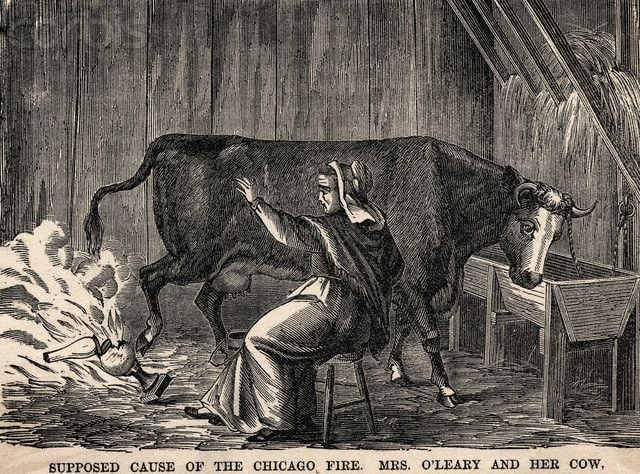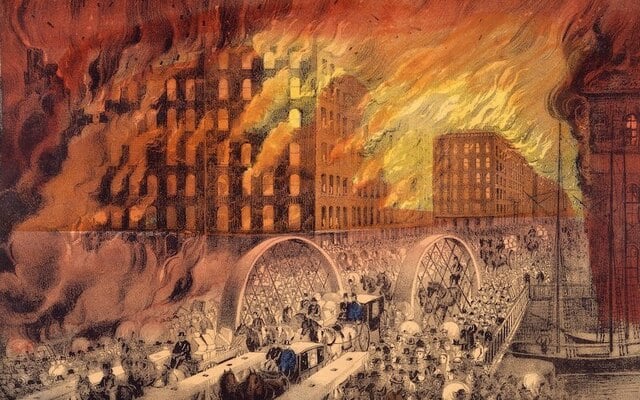Crime boss Big Jim O’Leary became one of Chicago's biggest gangsters but many don't know his humble and tragic roots.
One of the most successful Irish American crime bosses in turn of the century Chicago was James Patrick O’Leary, whose criminal career arose from the ashes of the Great Chicago Fire, of October 1871.
James O’Leary was born to Irish emigrants Patrick and Catherine O’Leary on January 23, 1869, in their home at 137 DeKoven Street, Chicago, Illinois. It was at this address, that the Great fire of Chicago started two years later. An event that would shape the lives and destiny of the entire O’Leary family.
Chicago in 1871 was growing rapidly and was a warren of streets and side alleys of wooden buildings.
Read more: These are the most Irish metropolitan areas in the US
October of that year was unseasonably dry and on the night on the evening October the 8th a fire began in a barn at the O’Leary family home. A high-wind and the dry conditions created a firestorm that destroyed thousands of buildings, killed over 300 people and caused $200 million in damages.
In the aftermath of the devastation, the Chicago Tribune was quick to attribute blame. One of its reporters, Michael Ahern, published a story that claimed that the great fire had been started by a cow kicking over a lantern while it was being milked. Ahern did not name the owner of the cow, but as the fire had started in the O’Leary’s barn, Catherine O’Leary was soon everyone’s chief suspect.
The local newspapers began printing caricatures of Catherine milking the cow and starting the fire.
Read more: An Irishwoman was blamed for starting the Great Chicago Fire
Soon publications all over the United States followed suit and the blame for the destruction was now lying firmly at the feet of Catherine O’Leary.
At the official inquiry into the disaster, Catherine fervently denied being at fault. She testified under oath that she had been asleep in bed when the fire had started and was unaware of the danger.
This was reinforced by the testimony of the first person to raise the alarm a man with an unusual name Daniel ‘Pegleg’ Sullivan.
Pegleg was a neighbor of the O’Leary’s and he testified that he had gone to visit them at around 6pm and that while he talked to Mr. O’Leary, his wife was absent, asleep in bed.
He left the O’Leary house at around 8pm. On his way home he paused to light his pipe on the corner of the O’Leary’s property and it was then he first spotted the flames coming from their barn. Despite having only one leg, he claimed to have run to help, shouting fire!
He reached the barn and freed the animals inside and then roused the O’Leary’s who he claimed were still unaware of the fire.
However, the Chicago Tribune story and anti-Irish sentiment, still strong at the time made scapegoats of Catherine O’Leary and her family. Outrageous stories soon circulated. One claimed she was drunk at the time of the fire and had hidden the evidence of her crime. Others that all the incriminating evidence had been hidden to protect the O’Leary’s.
The official report from the inquiry did not blame Catherine O’Leary simply saying:
"Whether it originated from a spark blown from a chimney on that windy night, or was set on fire by human agency, we are unable to determine".
Catherine O’Leary died “heartbroken” nearly a hundred years before her family managed to clear her name.
However, the idea that the O’Leary’s cow had started the fire caught the popular imagination further stimulated by Ahern’s Chicago Tribune article.
Michael Ahern would later admit in 1893 that he had made the whole story up! However, it was too late for the O’Leary’s whose reputation had been tarnished and finances ruined.
They were forced to move with the infant James and his 2 siblings to a southside Chicago slum where James would grow up haunted by the stigma of the false allegations against his family.
Read more: Chicago cop tells of racism inflicted on Irish Famine women and children
Alone and grafting
It was in these rough streets that James grew up watching his mother gradually die heartbroken from acute pneumonia on July 3 1895. James was determined that he would drag himself up from this poverty and unwanted notoriety.
Leaving school early, James was never the less a very intelligent young man and he soon started working for local bookmakers. He decided to strike out on his own and set up his own bookmaking business based out of Long Beach Indiana, which was an off-track betting resort.
This venture didn’t last long and he soon went bankrupt and he was forced to work as a meatpacker in the Union Stockyards to make ends meet. It was while working there he was given the nickname that would stay with him for the rest of his life, Big Jim.
O'Leary married Annie McLaughlin, whose family lived next to the O'Leary's at the time of the fire. They were the parents of two sons and three daughters.
Ever the entrepreneur and determined to make something of himself, Big Jim O’Leary left the stockyards in 1892 and opened a Saloon bar which included Turkish baths, a restaurant, a billiard room, and a bowling alley.
Going back to his bookmaker roots, he also posted detailed race track results and other betting information near the entrance to the Stock Yards, which proved highly lucrative.
As his empire began to grow, O'Leary expanded further, opening a pool hall and another bookmakers in the rear of his saloon.
Big-time bullet-proof bookie
He quickly became one of the leading gamblers in Chicago and was known for taking bets on everything from presidential candidates to changes in the weather.
O'Leary had a reputation for fair dealing. Chicago's longtime alderman-vice lord, Michael “Hinky Dink” Kenna, said of him, "He was a square shooter. Big Jim never welshed on a bet. He was a good loser and his patrons had confidence in him that he would always pay off if he lost”.
O'Leary refused to bribe police, instead, he had his business fortified including the construction of an iron and zinc layered oak doors to his bar which were according to Jim himself was:
"Fireproof, bomb-proof, and police-proof."
Jim became tired of constant police harassment and requests for bribes and decided to try something novel. He bought a steamship ‘the City of Traverse’ and began to run illegal gambling on Lake Michigan.
Continually raided by the police the venture only lasted until 1907.
O’Leary was continually under surveillance by the authorities and under attack from rival gambling gangs.
However, big Jim was always one step ahead of them all and though he was indicted a number of times for gambling he was only ever convicted once in 25 years, this was at the age of 53, and as it was a first offense he was only fined $100!
Perhaps one reason that Big Jim evaded conviction for so long was the fact his son James Jr was married to the daughter of the Chicago chief of police! O’Leary also had a network of informers and was usually tipped off about any police raid.
One year before his riverboat venture failed in 1906, Mayor Edward Fitzsimmons Dunne briefly revoked O'Leary's saloon license.
Again Big Jim was as the Irish say too cute for them. He arranged to “sell” his Saloon to a trusted employee who then reapplied for a license.
Once this was granted Big Jim was back in business.
The authorities were not the only problem Big Jim faced. During 1907 and into 1908 a war erupted between the gambling factions in Chicago. O’Leary’s Saloon was bombed in 1907 and twice in 1908 but undeterred Big Jim rebuilt every time and meted out bloody retribution in return.
The war ended with the death of Chicago crime lord Michael Cassius MacDonald's death.
The path was now clear for Big Jim to take over complete control of the gambling on Chicago’s southwest side around his old stamping ground of the Union Stockyards. He duly did so also branching out into supplying illegal whiskey during prohibition.
No man who reached such heights could do so without ruthlessness and despite his genial appearance Big Jim was capable of violence. He was strongly suspected of involvement in one of the most infamous murders in Chicago criminal history, the death of mob boss James Colosimo.
Colosimo immigrated to Chicago from Italy in 1895. Starting as a barman, he cleverly cultivated connections with the police and corrupt politicians to quickly rise through the ranks of the Italian crime gangs. Within a few years, Colosimo controlled 200 brothels using the profits to expand into gambling and the protection rackets.
By 1909, Colosimo’s success was under threat from the other gangs in Chicago and he realized he needed extra muscle. He recruited Johnny "The Fox" Torrio from Brooklyn and made him his second in command.
When prohibition went into effect in 1920, Torrio pushed for the gang to enter into bootlegging, but Colosimo refused as he felt prostitution was easier and safer. Torrio decided that if he was to reap the massive rewards of prohibition then Colosimo had to die.
Big Jim, was a serious suspect for 2 reasons:
Firstly O’Leary was delivering whiskey on a regular basis and would not be suspected by Colosimo and secondly and more importantly he wished to create an alliance with the rising man in the Italian mafia, Jonny Torrio and what better way to do that than to help eliminate the obstacle to Torrio’s rise to the top.
A life in crime
Late in life, O'Leary mused to a reporter about his success: "How much have I cleaned up? I'm satisfied with the results. I've got enough to take a trip around the world when I sell my shop. Then I'm going to settle down in some little town."
Big Jim never got to do that, as he died of natural causes at the age of 56 in his home at 726 West Garfield Boulevard, on January 23, 1925. When Jim died his entire estate was valued at $10,200 this is despite having made millions of dollars over the years. But Big Jim O’Leary knew you had to keep up a good front and he always wanted to show his family had risen from the ashes of the great fire.
Jim and his wife are buried next to his parents in a Chicago cemetery.
After his death, the O'Leary gambling house continued to be run by a business partner for a few years, until, somewhat ironically, the place burned down in the second-biggest fire in Chicago history, the 1934 Stockyards fire.
Today, the Chicago Fire Department training academy is located on the site of the O’Leary property where the Great Chicago Fire started. In 1997, the Chicago City Council passed a resolution exonerating Catherine O’Leary, an Irish immigrant who died in 1895, and her cow.
I’m sure Big Jim would have been pleased his family was finally cleared.
Read more: Ireland's little-known Mermaid Saint
*Originally published in 2020. Updated in 2025.
This article was submitted to the IrishCentral contributors network by a member of the global Irish community. To become an IrishCentral contributor click here.




Comments